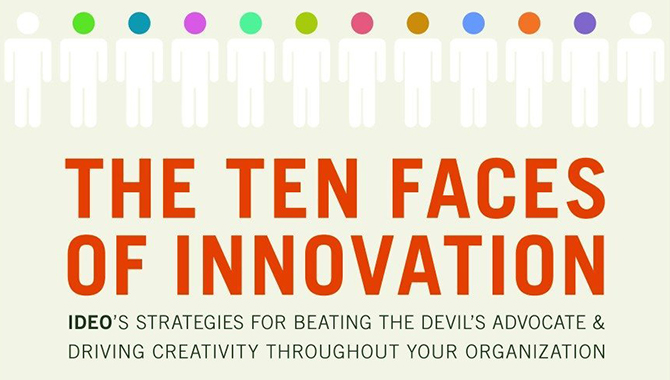
Here is a description of a book that we believe will interest ASK readers.
The Ten Faces of Innovation: IDEO’s Strategies for Beating the Devil’s Advocate and Driving Creativity Throughout Your Organization, by Tom Kelley with Jonathan Littman (New York: Currency/Doubleday, 2005)
As an award-winning innovation and design firm, IDEO creates new products and capabilities through observation-based research. Their successful designs include the first production mouse for Apple’s Macintosh computers (1981), the Palm V connected organizer for Palm Computing (1999), and Bank of America’s “Keep the Change” banking account service (2006). The design firm attributes its impressive track record to multidisciplinary teams and a collaborative culture combined with a methodology incorporating user observation, creative brainstorming, and prototyping.
IDEO’s Tom Kelley and Jonathan Littman describe ten roles, or personas, that they believe nurture innovation and protect against the insidious influences of the devil’s advocate. According to the authors, the three “learning personas” continually motivate themselves and others with new ideas. The Anthropologist brings tremendous powers of observation to form unique insights into human factors that solve problems. The Experimenter prototypes new ideas and takes calculated risks to find the next innovative breakthrough. The Cross-Pollinator applies new ideas from seemingly unrelated fields or diverse backgrounds. The authors give the example of escalators originating from a Coney Island amusement ride.
“Organizing personas” help new ideas survive time and budget pressures. The Hurdler overcomes challenges through perseverance and turns obstacles into opportunities (sometimes by bending the rules). The Collaborator’s great enthusiasm and diplomatic skills bring interdisciplinary teams together. The Director orchestrates continuous innovation efforts by gathering talented employees into effective teams and serving as a creative catalyst.
The “building personas” help create conditions in which new ideas grow. The Experience Architect creates experiences that motivate and delight. The Set Designer reinvents the work environment to inspire innovation. The Caregiver provides a supportive human-centered setting. The Storyteller makes an emotional connection through myths to convey information and provoke thought.
Kelley and Littman explain that the devil’s advocate appears regularly in the project rooms and boardrooms of corporate America, encouraging “the most negative possible perspective, one that sees only the downside, the problems, the disasters-in-waiting.” Their view of the devil’s advocate differs from other noted authors in the innovation arena, who laud the role as a positive pressure point for guiding new ideas. According to Kelley and Littman, the devil’s advocate kills new ideas. The ten nurturing personas counter that negativity with innovative possibilities.
Kelley also notes that individuals may take on multiple roles or switch roles depending on their context. The personas cannot guarantee innovation, and not every successful innovative group will include all ten, but the book provides insight into the sources of innovation that NASA readers can usefully apply to their own groundbreaking work.







